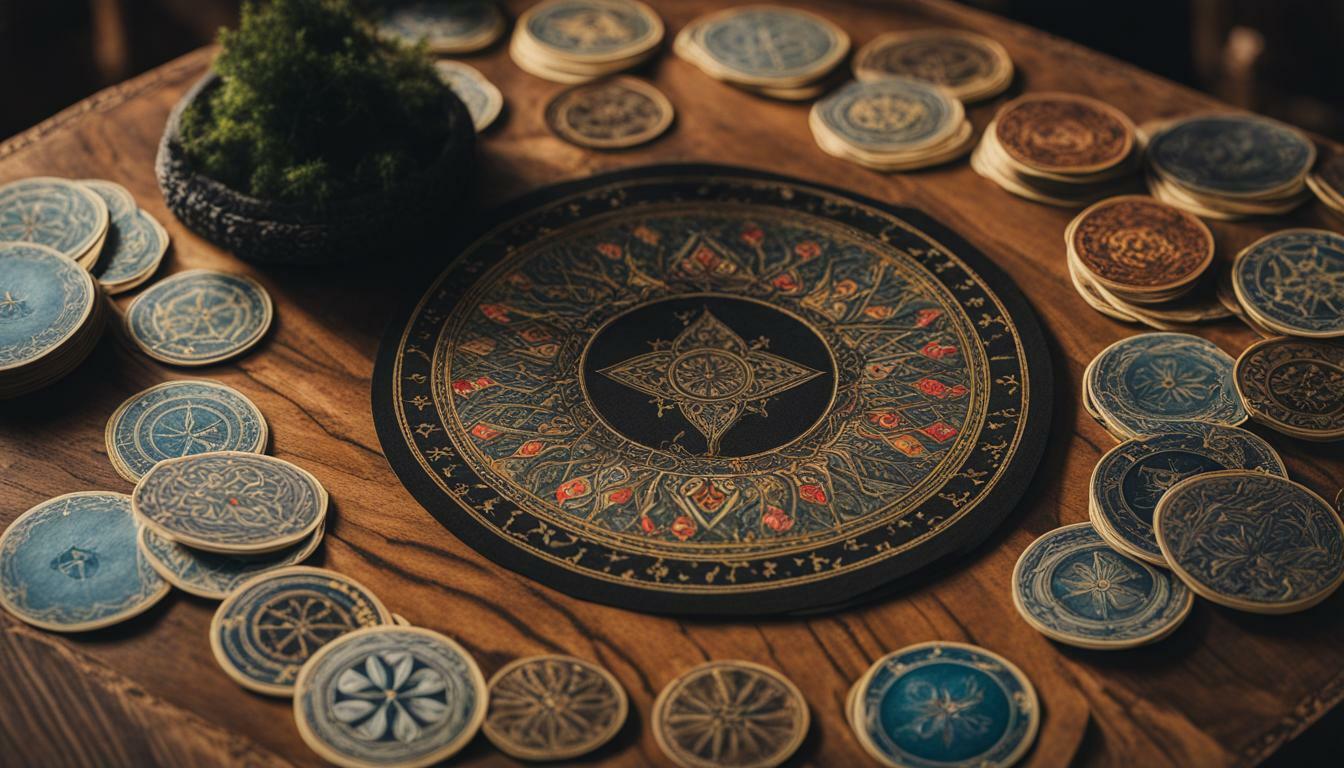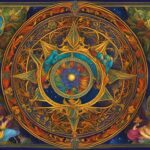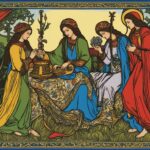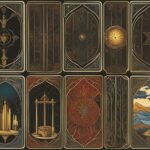Tarot card decks consist of a specific number of cards that are divided into two main groups. The deck is composed of 78 cards in total, with 22 cards belonging to the Major Arcana and 56 cards to the Minor Arcana.
Key Takeaways:
- A tarot card deck consists of 78 cards divided into Major Arcana and Minor Arcana.
- The Major Arcana consists of 22 cards that represent major forces and have specific meanings in divination.
- The Minor Arcana consists of 56 cards divided into four suits (Wands, Pentacles/Coins, Cups, and Swords), each with its own general meaning.
- The most popular tarot card deck is the Rider-Waite deck, featuring suggestive images on all the cards, first published in 1909.
- Tarot cards share their origin with playing cards, but there are significant differences between the two.
Understanding the Composition of a Tarot Card Deck
A tarot card deck is made up of a combination of major and minor arcana cards. The deck consists of a total of 78 cards, each with its own significance and symbolism. The cards are divided into two main groups: the Major Arcana and the Minor Arcana.
The Major Arcana, also known as the trump cards, consists of 22 cards. These cards represent major forces and themes in tarot divination. Each card carries a specific meaning and can provide insights and guidance into various aspects of life. The Major Arcana cards are often seen as the core essence of the tarot deck, offering deep reflection and spiritual wisdom.
The Minor Arcana, on the other hand, is made up of 56 cards and is divided into four suits: Wands, Pentacles/Coins, Cups, and Swords. Each suit has its own general meaning and represents different areas of life. The Wands suit signifies creativity, passion, and ambition, while the Pentacles/Coins suit represents material possessions, wealth, and abundance. The Cups suit relates to emotions, relationships, and intuition, and the Swords suit is associated with intellect, communication, and challenges.
It is important to note that the composition of the tarot card deck can vary slightly depending on the specific deck being used. However, the standard tarot deck generally follows this structure and includes the major and minor arcana cards mentioned above.
| Card Type | Number of Cards |
|---|---|
| Major Arcana | 22 |
| Minor Arcana | 56 |
| Total | 78 |
The Major Arcana: Exploring the Forces within Tarot
The major arcana cards in a tarot card deck hold great significance and symbolism. These cards represent the major forces at work in our lives and provide deep insights into our journey of self-discovery and personal growth. Comprising of 22 cards, the major arcana takes us on a profound journey through various archetypal themes and experiences.
Each major arcana card has its own unique symbolism and meaning, offering guidance and wisdom for those seeking answers and clarity. From the mystical and enigmatic Fool to the transformative power of Death, these cards touch upon universal themes and emotions that resonate with our deepest selves. The major arcana cards act as powerful tools for introspection, helping us navigate life’s challenges and gain a deeper understanding of ourselves and the world around us.
When conducting a tarot reading, the major arcana cards often carry more weight and significance than the minor arcana cards. They represent the bigger picture and the overarching energies influencing our lives. Whether we pull the Emperor card, embodying authority and structure, or the Empress card, representing nurturing and abundance, each major arcana card has a message to impart and a lesson to teach.
Table: Major Arcana Cards and their Meanings
| Card | Symbolism | Meaning |
|---|---|---|
| The Fool | Leaps of faith, new beginnings | Embarking on a new journey, embracing spontaneity |
| The Magician | Manifestation, resourcefulness | Harnessing personal power, utilizing skills and talents |
| The High Priestess | Intuition, inner wisdom | Exploring the depths of the subconscious, connecting with intuition |
| The Empress | Nurturing, abundance | Celebrating creativity, embracing femininity |
| The Emperor | Authority, structure | Establishing order, taking control of situations |
As you delve into the major arcana cards of a tarot card deck, you will uncover a wealth of wisdom and insight. Each card holds a story, a lesson, and a profound message that can assist you on your personal and spiritual journey. By tapping into the energies and symbolism of the major arcana, you can gain a deeper understanding of yourself, your purpose, and the forces at play in your life.
The Minor Arcana: Unveiling the Suits and Meanings
The minor arcana cards in a tarot card deck are categorized into suits, each carrying its own unique symbolism. These suits are Wands, Pentacles/Coins, Cups, and Swords. Let’s explore each suit and its corresponding meanings:
1. Wands
The suit of Wands represents creativity, passion, and ambition. It is associated with the element of fire, signifying energy and inspiration. Wands cards often indicate growth, action, and the pursuit of goals. They can signify new beginnings, leadership, and the exploration of one’s passions.
2. Pentacles/Coins
The suit of Pentacles, also known as Coins, represents the earthly aspects of life, including material possessions, finances, and career. It is associated with the element of earth, symbolizing stability and practicality. Pentacles cards often indicate abundance, prosperity, and the rewards of hard work. They can also represent the importance of grounding oneself and focusing on the physical realm.
3. Cups
The suit of Cups represents emotions, relationships, and intuition. It is associated with the element of water, symbolizing fluidity and the realm of the subconscious. Cups cards often indicate matters of the heart, love, compassion, and emotional fulfillment. They can also signify creativity, intuition, and the exploration of one’s inner world.
4. Swords
The suit of Swords represents intellect, communication, and challenges. It is associated with the element of air, signifying mental clarity and logic. Swords cards often indicate conflicts, decisions, and the need for clear thinking. They can symbolize truth, reason, and the power of the mind. Swords cards may also represent the need for assertiveness and the ability to overcome obstacles.
By understanding the meanings of the minor arcana suits, you can gain deeper insights into the messages conveyed by tarot cards. Each suit offers a unique perspective and allows for a holistic understanding of various aspects of life. Whether you are seeking guidance or exploring your own intuition, the minor arcana serves as a valuable tool for self-reflection and personal growth.
The Most Popular Tarot Card Deck: Rider-Waite
The Rider-Waite tarot card deck is one of the most popular and influential decks ever created. First published in 1909, it has become a staple in the world of tarot reading, cherished by both beginners and experienced practitioners alike. What sets this deck apart is its remarkable imagery that captivates and inspires.
Featuring 78 cards, the Rider-Waite deck is divided into two main groups: the Major Arcana and the Minor Arcana. The Major Arcana consists of 22 cards, each representing a significant force or archetype in the human experience. These cards, such as The Fool, The Emperor, and The World, hold profound meaning and provide insight into life’s journey.
The Minor Arcana, on the other hand, comprises the remaining 56 cards and is further divided into four suits: Wands, Pentacles/Coins, Cups, and Swords. Each suit represents a different aspect of life and carries its own significance in tarot divination. Together, the Major and Minor Arcana cards of the Rider-Waite deck create a rich tapestry of wisdom and guidance.
It’s worth noting that while the Rider-Waite tarot card deck has become synonymous with tarot reading, there are many other decks available, each with its own unique interpretations and symbolism. However, the Rider-Waite deck remains a beloved choice for its timeless appeal and its ability to resonate with readers of all backgrounds.
| Deck | Number of Cards | Major Arcana | Minor Arcana |
|---|---|---|---|
| Rider-Waite | 78 | 22 | 56 |
Tarot Cards and Playing Cards: Understanding the Differences
While tarot cards and playing cards have a common origin, there are significant differences between the two. Tarot cards, consisting of 78 cards in total, are commonly used for divination and cartomancy since the 16th century. The deck is divided into two main groups: the Major Arcana, which contains 22 cards representing major forces and specific meanings in divination, and the Minor Arcana, which comprises 56 cards divided into four suits.
The Minor Arcana cards are categorized into four suits: Wands, Pentacles/Coins, Cups, and Swords. Each suit carries its own general meaning, allowing for a more nuanced interpretation in readings. The Major Arcana cards, on the other hand, hold significant symbolic value and typically represent major life events and spiritual journeys.
One of the most well-known and widely used tarot decks is the Rider-Waite deck, first published in 1909. This deck stands out with its suggestive images on all the cards, which have made it a favorite among both beginners and experienced readers. The Rider-Waite deck’s popularity has ensured that it remains the standard tarot deck size used by many today.
Despite their shared origins, tarot cards and playing cards differ in purpose and design. While playing cards are primarily used for games and gambling, tarot cards have a deeper spiritual significance and are primarily employed for divination. Playing cards typically have a simpler design, with each suit containing numbered cards and face cards like kings, queens, and jacks. In contrast, tarot cards have more complex symbolism, with each card depicting unique imagery that holds specific meaning in divination.
| Tarot Cards | Playing Cards |
|---|---|
| Used for divination and spiritual guidance | Used primarily for gaming and gambling |
| 78 cards in total | 52 cards in total |
| Divided into Major Arcana and Minor Arcana | Divided into suits and face cards |
| Rich symbolism and imagery | Simple design with numbered cards and face cards |
With their unique symbolism and spiritual significance, tarot cards continue to captivate and offer insights into the mysteries of the human experience. Whether you are a believer in their mystical powers or simply appreciate their artistic beauty, exploring the world of tarot cards can be a fascinating journey of self-discovery.
Conclusion
Understanding the composition and number of cards in a tarot card deck is essential for anyone interested in delving into the mystical practice of tarot. A tarot card deck consists of 78 cards, which are divided into two main groups: the Major Arcana and the Minor Arcana.
The Major Arcana holds great significance, with 22 cards representing major forces and carrying specific meanings in divination. These cards, such as The Fool, The Magician, and The Emperor, offer deep insights into life’s journey and spiritual growth.
The Minor Arcana, on the other hand, encompasses the remaining 56 cards. It is divided into four suits: Wands, Pentacles/Coins, Cups, and Swords. Each suit has its own general meaning, reflecting various aspects of human experience, emotions, challenges, and opportunities.
One of the most popular and widely recognized tarot card decks is the Rider-Waite deck. First published in 1909, it features suggestive images on all its cards, making it accessible and captivating for both beginners and experienced practitioners.
While tarot cards share their origin with playing cards, they have evolved into a distinct practice with significant differences. Tarot cards have been used for divination and cartomancy since the 16th century, providing guidance and insight through their symbolic imagery and intuitive interpretations.
Today, many versions of the tarot card deck are in the public domain, allowing enthusiasts to explore and use them freely. Whether you are seeking self-reflection, spiritual guidance, or a deeper understanding of the human experience, the tarot card deck offers a rich and fascinating tool to embark on your personal journey.
FAQ
Q: How many cards are in a tarot card deck?
A: A standard tarot card deck consists of 78 cards, divided into two groups: the Major Arcana and the Minor Arcana.
Q: What is the composition of a tarot card deck?
A: The tarot card deck is composed of 22 Major Arcana cards and 56 Minor Arcana cards. The Major Arcana cards represent significant forces, while the Minor Arcana cards are divided into four suits: Wands, Pentacles/Coins, Cups, and Swords, each with its own general meaning.
Q: What are the most popular tarot card decks?
A: The Rider-Waite tarot card deck is the most popular and widely recognized deck. It was first published in 1909 and features suggestive images on all its cards.
Q: How do tarot cards differ from playing cards?
A: Although tarot cards share their origin with playing cards, there are significant differences between the two. Tarot cards have been used for divination and cartomancy since the 16th century and have specific meanings in divination, while playing cards are primarily used for games and have a different system and purpose.
Q: Can I freely use tarot card decks?
A: Many versions of tarot card decks are now in the public domain, which means they can be freely used. However, it is always important to check the copyright status of a specific deck before use.








